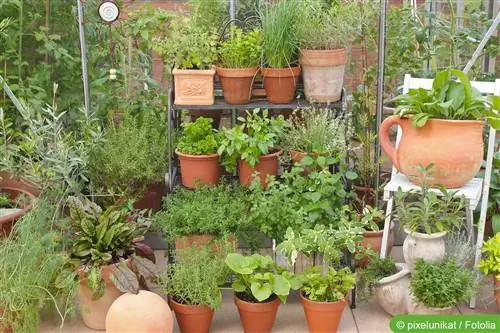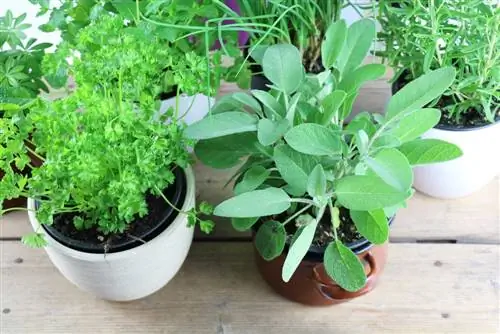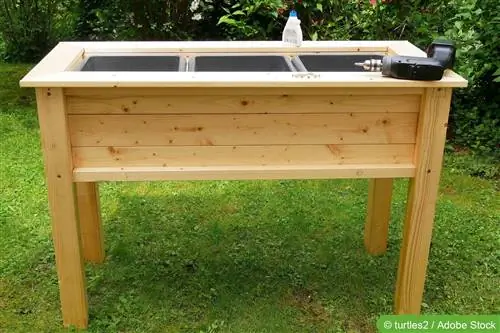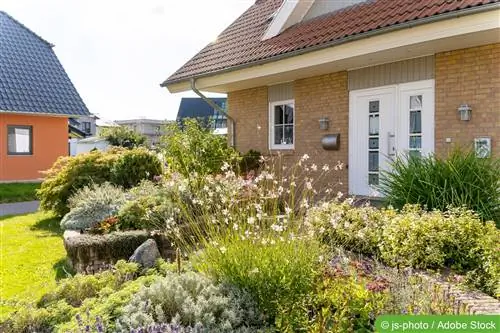- Author admin [email protected].
- Public 2023-12-17 03:39.
- Last modified 2025-06-01 06:48.
Herbs are spicy and tasty, and many types of herbs also have healing effects. With your own herb garden, your menu can be supplemented with hearty herb plants, which can be harvested as needed. Herbs are not only suitable for seasoning dishes, but also for preparing teas and refreshing cold drinks. When planting a herb garden, the location conditions and the selection of herbs play an important role so that the gardener can count on a rich harvest over a long period of time.
Selection of location
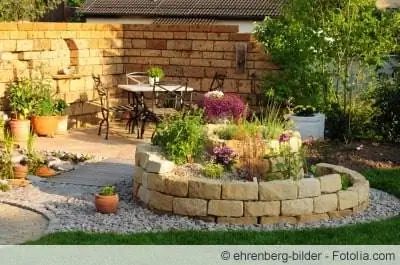
The gardener can decide where the herb garden will be planted as desired, but some important requirements should be met. Most types of herbs require a lot of light, so the location should have sufficient sunlight. Some herbs prefer a short-term shady place; this factor can be achieved by having perennial plants or small trees in the immediate vicinity. Which location conditions are preferred depends primarily on the origin of the herb variety. Herbs generally don't need a lot of space and grow and thrive in almost all bed shapes and planters:
- Sunny to full sun locations are ideal for Mediterranean herbs
- Native species usually prefer partially shaded locations
- Base area of around 2-5 sqm is completely sufficient
- Measure the respective area carefully before setting up
- Make sure the soil is permeable and nutrient-rich
- Observe different requirements of the varieties regarding the nutrient content of the soil
- Divide the herb garden into various zones with different conditions
- Be sure to include the spread, growth habit and winter hardiness of the herbs in the planning
Tip:
Always plant the herb garden in the immediate vicinity of the house so that the herbs can be harvested fresh quickly and without much effort.
Design & Shape
A herb garden can be easily integrated into an existing vegetable garden, but a separate area can also be created for the herbs. There are no limits to the imagination when it comes to design and shape, but certain shapes have proven to be effective when it comes to care, due to the different requirements of the herbs. These include, above all, the spiral-shaped herb snail and the practical raised bed. When setting up a herb garden, you should always make sure that it is not too large and that it is easy to reach and walk through from all sides. Natural materials are ideal as a surface for the paths around the bed and between the individual bed sections, which are easy to walk on even when wet. In addition, the beds can be bordered with attractive stones, practical palisades or a hedge; low-growing varieties such as boxwood are ideal here:
- Draw a plan before laying, should include the location and size of the area
- Draw the beds completely with paths, pay attention to simple concepts
- Plan geometrically simple shapes and sensible distances
- Suitable materials for the paths: gravel, grit and natural stones
- Classify bed sections according to herbs with compatible location requirements
- Raised beds are easier to harvest
- Designs from the area of rock and cottage gardens are very visually appealing
- Herb spiral with stone surround covers different location requirements
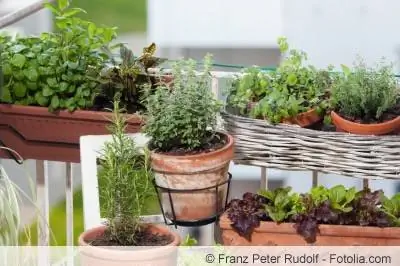
Tip:
If you have a clear budget for designing the herb garden, laying out bark mulch as a substrate for the paths is a good idea. This way, the herbs can still be easily reached even when it rains, without getting your feet wet.
Design with stones
Stones can be used excellently as design elements in the herb garden and serve to demarcate and protect sensitive herbs. In this way, various sections with different location conditions can be created in the herb bed. Laying gravel makes the herb garden easier to maintain and is easy to place between the planted areas. In order for Mediterranean medicinal and herbal plants to thrive perfectly, they need a warm and protected place due to the local temperature conditions. When cultivating heat-loving herbs from southern European countries, it has proven useful to create a herb spiral, which should be placed in a sunny location:
- Garden wall made of natural stones forms a boundary between beds and other garden areas
- Use stones as drywall to delimit bed sections
- Use flat stone slabs at some distance as a stepping surface
- Stone bed with gravel laid out prevents weeds from growing
- Use sandstones as protection for Mediterranean herbs
- Light sandstone stores the heat given off by the sun and passes it on to the herbs
Selection of herbs
The range of herbs and medicinal plants is very large; the selection should be based on personal taste and individual preferences. In addition, the intensity of care and the location requirements of the respective varieties must also be taken into account; the selected plants should be able to adapt to the local climatic conditions without difficulty. In order for the herbs to be used regularly, they must be suitable for your favorite foods and drinks. With exotic herb varieties, it is better to try them before planting, as there are often unpleasant surprises when it comes to the taste. When it comes to herbal plants, a distinction is made between annual, biennial and perennial varieties, which have different care requirements:
- Proven annual herb varieties: dill, chervil, coriander, cress and marjoram
- Biennial and perennial herbs: basil, caraway, lavender, lovage, mint, oregano, parsley, rosemary, sage, chives, thyme and lemon balm
- Mediterranean herbs are extremely sun-tolerant and thrive even on poor soils
- Southern herbs: lavender, oregano, rosemary, sage and thyme
- Herbs for sunny and partially shaded locations with nutrient-rich soil: dill, coriander, lemon balm and mint
- Varieties for partially shaded, humus-rich and slightly moist places: tarragon, nasturtium, chervil, marjoram, parsley and chives
- Sorrel and woodruff are ideal for shady, humus-rich and moist locations
Sowing & Planting
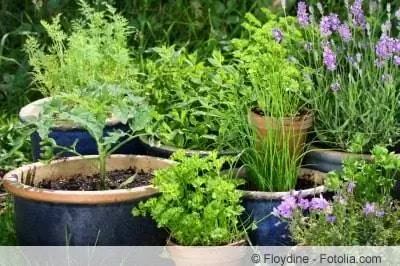
Specialist retailers now have a wide range of seeds and pre-grown young plants that can be used to start a herb garden. Herbs that are not hardy can only be cultivated in planters; at the end of autumn, these sensitive varieties must be moved to suitable winter quarters. When sowing and planting, the right time is crucial so that the herbs can grow and thrive without any problems:
- Loosen the soil well before planting
- Sowing annual herbs as seeds in the herb garden
- The ideal time for sowing is from mid-May, after the last ground frosts
- Cover freshly sown herb seeds with some garden fleece immediately after sowing
- Initial cover promotes germination
- Sowing biennial and perennial herbs the previous September
- Alternatively plant as early perennial plants in spring or autumn
Care
If the location conditions are right, the amount of care required in the herb garden is minimized, so these factors must be taken into account, otherwise the herb bed will require a lot of unnecessary work. Water the herb plants either in the morning or in the evening when the sun's rays are not yet at their full strength or are no longer at their full strength. Otherwise, the irrigation water can burn the herbs and cause them to die. The Mediterranean herbs only need a little water and can cope well with nutrient-poor soils, so they don't need a lot of fertilizer. When it comes to herbs, it is better to avoid chemical fertilizers, as these not only harm your he alth, but also negatively affect the taste of the respective type of herb:
- Avoid waterlogging at all costs
- Place soil in buckets and pots with a layer of gravel or granules
- Southern varieties cope well with heat and drought
- Native herbs need protected places with constant watering units
- Fertilize with compost once or twice a year, either in spring and/or autumn
- Water regularly and remove weeds
- Move non-hardy herbs to suitable winter quarters at the end of autumn
- When winter sets in, cover sensitive herbs with fleece or sticks
Planting a herb garden - a selection of popular plants

There are many popular garden herbs. Before you start creating a herb bed, you should first ask yourself which herbs are actually often used in the kitchen. In addition to a “minimum herb stock”, it is always worth growing some rare herbs. However, from experience we can say that the number of herbs that are often used usually remains manageable.
A small selection of the plants that are at home in many herb gardens:
- Parsley - versatile and popular, is sown annually or every two years.
- Chives - can overwinter in the herb bed for years.
- Sage - grows into a lush shrub, plan enough space when planting.
- Thyme - goes very well with dishes that contain tomatoes and peppers.
- Rosemary - likes it sunny, goes well with meat dishes, is an ingredient for the popular rosemary potatoes.
- Savory - gives bean dishes the right flavor.
- Dill - goes well with any cucumber salad.
- Peppermint - alongside lemon balm, it is unbeatable as a tea ingredient.
- Lavender - smells intense and can also be used as a soap ingredient.
- Tarragon - gives salads pep.
- Chamomile - popular medicinal plant that is said to help with stomach problems.
- Basil - Basil leaves are a must on any tomato and mozzarella plate. Danger! Snails also like basil.
Conclusion
A herb garden can be set up quickly and provides dedicated hobby cooks with lots of fresh herbs for preparing food and drinks. When choosing a location, it is important to take the requirements of the various herbs into account, otherwise they will quickly wither away. With a spiral-shaped herb snail, different site conditions can be simulated in a small space in order to be able to plant many different types of herbs. A practical raised bed makes the gardener's work easier and also offers good protection from pests and bad weather conditions. The spicy smell and hearty taste of the herbs are well worth the time spent.

